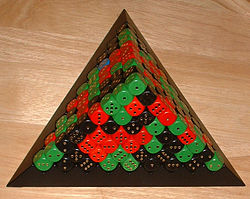Portal:Spiele/Teilnehmer
Portalseite • Diskussion • Qualitätssicherung • Wartung/Mitarbeit • Kategorien • Kat-Diskussion • Teilnehmer • Wikipedia spielt …
Aktive Wikipedianer des Portals Spiele Bitte in alphabetischer Reihenfolge eintragen | |
Achim Raschka
Kontakt aufnehmen | |
Dwain
Kontakt aufnehmen | |
Guinsoo
Kontakt aufnehmen | |
Heiko
Kontakt aufnehmen | |
HirnSpuk
Meine Diskussionsseite | |
Immanuel Giel
Kontakt aufnehmen | |
Just N.
| |
KnightMove
Kontakt aufnehmen | |
Micha L. Rieser
Kontakt aufnehmen | |
RedPiranha
Kontakt aufnehmen | |
Rogi
Mein Postfach | |
Roland Scheicher
Kontakt aufnehmen | |
Ruhrgur
Kontakt aufnehmen | |
Saehrimnir
Kontakt aufnehmen | |
Stefan64
Kontakt aufnehmen | |
Tillmann Walther
Kontakt aufnehmen | |
Traitor
Kontakt aufnehmen | |
Auf dieser Seite verwendete Medien
Autor/Urheber: Alan Light, Lizenz: CC BY-SA 3.0
Schachfiguren – von links nach rechts: König, Turm, Dame, Bauer, Springer und Läufer.
Autor/Urheber: Ruhrgur, Lizenz: CC BY-SA 4.0
Zwei Charaktere bekämpfen einen erwachsenen weißen Drachen. Zu sehen sind außerdem Würfel (W4-20) und ein Dungeons and Dragons Charakterbogen der 5. Edition.
Autor/Urheber: Niccolò Caranti, Lizenz: CC BY-SA 4.0
Illustrator Michael Menzel at Lucca Comics and Games 2015
Mummadi Krishnaraja Wodeyar had the longest reign among rulers of Mysore (1799 - 1868). He had varied interests in life -- music, painting, literature -- each of which he loved and tried his hand in. He spent liberally on promotion of learning and patronized a number of scholars. He is credited with the authorship of 109 works in Kannada and Sanskrit! It was a common custom in royal courts for littérateurs to write and dedicate their works to their patrons, or to seek permission to lend his name to their writings. But, among the works attributed to Mummadi, scholars are united in identifying some Devata-Stutis (hymns in praise of Gods), a work on games and Sougandhika Parinaya (wedding of Sugandhika), a prose romance, as Mummadi's own creation.
Sougandhika Parinaya (Parinaya = wedding) was a new experiment in prose-writing. Neither borrowed nor adopted, it has a mythological theme written in puranic style. The same work was later rendered into poetry (6,000 verses) and a play was also written, showing its popularity.
The theme involves Lord Indra, the king of heaven. Under a curse by the sage Durvasa he is born as prince Sugandharaja in the land of Karnataka to pious parents. His childhood, youth and training for kingship are described. His several exploits to win over princess Sougandhika who was born under similar circumstances, in Kalinga form the bulk of book. There are several episodes incorporated, while Sugandharaja starts to fulfil eight conditions laid down by Sougandhika to marry her. Religion, Philosophy, Yoga, astronomy, erotics, zoology, botany, music, horse and elephant-lore, horticulture, digging of wells and lakes, in short all topics a king was supposed to study are discussed. The prince excelled in all!
The book is profusely illustrated. Mummadi had started a lithograph press in the palace premises and himself was a painter. He experimented with color pictures.
True to the tradition of religious tolerance of the land, equal importance is given to Hari and Hara that is Vaishnava and Shaiva Sectarian worship. However, prominence is given to Chamundeshwari, the titular-deity of Mysore Kings. All chapters start with prayers to Shri Chamundeshwari with whose blessings the prince is able to achieve his goal and marry his dream-girl. Nanjundeshwara also figures as an important deity.
Autor/Urheber: RedPiranha, 19.10.2007 auf der Spiel in Essen, Lizenz: CC BY-SA 3.0
Caylus-3-D-Version
Logo des Brettspiels "Die Siedler von Catan" des Kosmos-Verlags
Autor/Urheber: Traitor, Lizenz: CC BY-SA 3.0
Two 10-sided dice, originals from the MERP box set, showing the result 96.
Moderner Backgammontisch aus Birnenholz mit Spielfläche aus Leder-Intarsia, Entwurf: Mag. art. Alois Scheicher



























